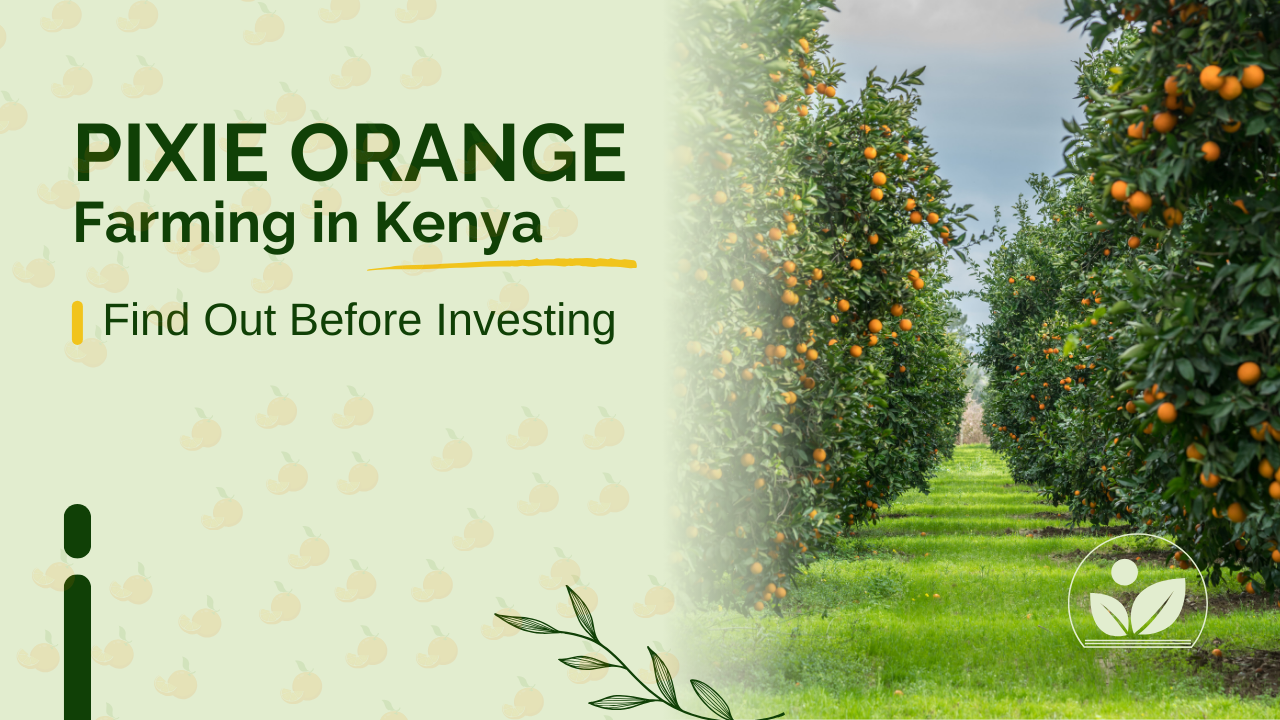Pixie Orange Farming in Kenya: Everything You Need to Know

Introduction
Farming in Kenya has always been a profitable business—as long as you play by the books. Whether you’re growing maize, managing a dairy farm, or experimenting with horticulture, there’s real money to be made if you follow proper practices. And if you’ve decided to check out Pixie Orange Farming in Kenya, you’re in the right place. This guide is crafted for farmers, aspiring agripreneurs, and curious investors alike.
In this blog, you’ll learn all about pixie farming in Kenya—from identifying the best counties for cultivation (yes, some regions are a no-go, sorry!) to understanding how to plant pixie oranges, the ideal soil types, necessary precautions, common challenges, and the estimated costs and returns. We’ll even explore the current pixie oranges price in Kenya, what drives it, and whether you’re looking at a gold mine or a lemon (pun intended). Ready to grow your agri-fortune? Let’s dive in.
Best Regions for Pixie Orange Farming in Kenya
Pixie Orange Farming in Kenya isn’t a one-size-fits-all venture. Climate and elevation play massive roles in determining where your pixie orchard will thrive. The best counties for pixie farming in Kenya include Murang’a, Kiambu, Nyeri, Embu, Meru, and parts of Kericho. These areas share one key thing: they sit at high altitudes (1,200–2,100 meters above sea level) and boast cool temperatures with well-distributed rainfall.
Here’s the kicker—if your county isn’t on that list, you might want to reconsider. Pixies don’t perform well in low-altitude areas with poor drainage or erratic rainfall. The trees become susceptible to fungal infections and produce low-quality fruits. Soil also matters—a lot. Opt for well-drained red loam or sandy loam soil with a neutral to slightly acidic pH (5.5–6.5). Clay soils? Forget it. Drainage is poor, and roots rot faster than your patience.
Here’s a quick table of ideal counties and why they’re top picks:
| County | Altitude (m) | Soil Type | Suitability |
|---|---|---|---|
| Murang’a | 1,500–2,000 | Red Loam | Excellent |
| Kiambu | 1,400–1,800 | Sandy Loam | Excellent |
| Nyeri | 1,600–2,100 | Loam | Very Good |
| Meru | 1,300–2,000 | Loam | Very Good |
| Embu | 1,200–1,800 | Well-drained | Good |
| Kericho | 1,800–2,000 | Sandy Loam | Good |
If your area isn’t listed, consider other fruits like pawpaws or bananas. Pixies demand premium real estate.
How to Plant Pixie Oranges
Getting into pixie orange farming in Kenya starts right from the seed—or more accurately, the seedling. The best approach is to buy certified, grafted pixie orange seedlings from reputable nurseries. These are disease-resistant and start fruiting faster—typically within 2.5 to 3 years.
Step-by-Step Guide on How to Plant Pixie Oranges
- Site Preparation: Clear the land and test your soil. Ensure it drains well. If not, consider raised beds or mounds.
- Digging Holes: Dig holes 2ft deep and 2ft wide, spaced 4×4 meters apart. This gives enough room for canopy growth.
- Soil Treatment: Mix topsoil with manure and a handful of DAP fertilizer. Let it settle for two weeks.
- Planting: Position the seedling upright in the hole, cover, and water it generously.
- Watering Schedule: Water every 2–3 days during the dry season. Pixies love moisture but hate soggy feet.
A helpful tip: Mulch around the base to conserve moisture and prevent weed growth. And no, using cow dung straight from the shed doesn’t make you a soil guru—it needs to be well-rotted compost, folks!
After planting, regular care includes pruning, pest management, and monitoring for citrus canker and black spot. Don’t skimp on this—lazy farmers harvest regrets.
Costs and Profitability of Pixie Farming in Kenya
Let’s talk numbers. The upfront cost of Pixie Orange Farming in Kenya can feel hefty—but the long-term profits? Oh, they’re juicy. On average, establishing a one-acre pixie farm will cost between Ksh 250,000 to Ksh 350,000. This covers land prep, seedlings (at Ksh 150–250 each), fertilizers, manure, labor, and initial irrigation.
Estimated Breakdown of 1-Acre Investment:
| Expense | Cost (Ksh) |
|---|---|
| Grafted Seedlings (250 @ Ksh 799) | 199,750 |
| Land Preparation | 30,000 |
| Fertilizer & Manure | 40,000 |
| Irrigation Setup | 60,000 |
| Labor | 50,000 |
| Pest & Disease Control | 20,000 |
| Miscellaneous | 30,000 |
| Total | ~429,750 |
Now, let’s talk profits. A mature pixie tree yields about 400–600 fruits annually. With 250 trees per acre, that’s 100,000 to 150,000 fruits. Given the pixie oranges price in Kenya averages around Ksh 20 per fruit (wholesale), you’re looking at annual revenue of Ksh 2M to 3M once the trees mature.
Initial setup costs, especially with seedlings priced at Ksh 799 each (Here), push your investment closer to Ksh 430,000 per acre. But here’s the good news: your return on investment (ROI) can be recouped by the 4th year, and after that, it’s straight profit—season after season.
So, how profitable is pixie orange farming in Kenya? Extremely—if you get the basics right. Think of it as farming with foresight: pay more now, earn more later. Just don’t cut corners on quality inputs; the trees know, and they will snitch on your harvest.
Challenges in Pixie Orange Farming
While Pixie Orange Farming in Kenya is lucrative, it’s not a walk in the orchard. First off, pests and diseases are your daily battles. The most common culprits? Citrus canker, black spot, aphids, and mealybugs. Without timely spraying and proper sanitation, your yields can suffer big-time. Remember, a sick pixie tree is a stingy pixie tree.
Another headache? Climate change. Unexpected droughts, hailstorms, and fluctuating rainfall patterns can wipe out an entire season. That’s why irrigation (drip is best) and mulching aren’t optional—they’re your insurance policy.
Let’s not forget market access. Yes, the pixie oranges price in Kenya is high—but only if you hit premium markets. Rural sales won’t fetch the same rates as Nairobi supermarkets or export buyers. Without a plan to reach these markets, you’re farming blind.
Also, fake seedlings from unscrupulous nurseries are a real trap. Buy from certified sources only, or you might end up with ornamental trees instead of fruit-bearing ones. Spoiler alert: They don’t taste good.
In short, pixie farming in Kenya demands vigilance, investment, and hustle. But the payoff? Totally worth it.
Conclusion
Pixie Orange Farming in Kenya isn’t just another agribusiness trend—it’s a high-potential investment that rewards patience, planning, and precision. If you’re farming in the right county with suitable soils, reliable water, and certified seedlings, you’re on the path to harvesting golden orbs of profit. The market is growing, both locally and for export, and the demand for pixie oranges Kenya continues to rise due to their sweet taste, long shelf life, and health benefits.
But hey, no sugarcoating—it’s not all sunshine and sweet fruit. You’ll need to navigate pest management, climate unpredictability, and market dynamics. Still, the math is on your side. With the right input, your trees could start turning in Ksh millions by the fourth year. So, whether you’re a seasoned farmer or green to the soil, if you’re in the right zone, it might be time to plant your future—one pixie tree at a time. Ready to farm smart? Let’s go get that citrus cash.
FAQs
What is the ideal climate for pixie orange farming in Kenya?
Pixie oranges thrive in cool, high-altitude regions with well-distributed rainfall. The optimal elevation is between 1,200 to 2,100 meters above sea level.
How long do pixie oranges take to mature and start bearing fruit?
Grafted pixie orange trees typically start producing fruit after 2.5 to 3 years, with peak yields achieved around the 5th year.
Can I grow pixie oranges in lowland or coastal areas of Kenya?
Unfortunately, no. These areas are generally too hot and humid, increasing the risk of diseases and poor fruit quality. Highland counties are much more suitable.
How many pixie orange trees can I plant in one acre?
With proper spacing of 4×4 meters, you can comfortably plant about 250 pixie trees per acre.
What’s the shelf life of pixie oranges after harvesting?
Pixie oranges have a relatively long shelf life of 3–4 weeks when stored in cool, dry conditions, making them ideal for both local and export markets.
Is there a market for pixie oranges in Kenya?
Yes, and it’s growing! Demand is high in urban centers like Nairobi and for export. Many farmers also supply directly to juice processors and supermarkets.

